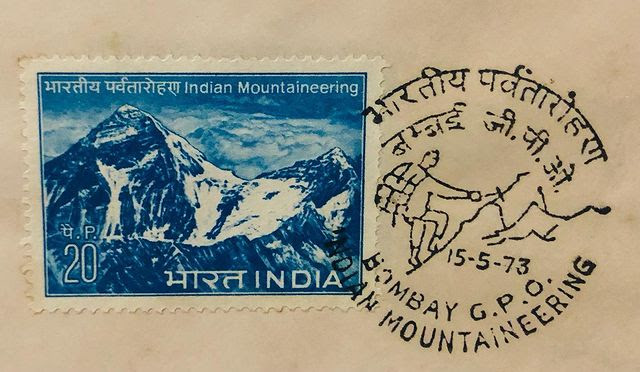Indian mountaineering stamp was launched in 1973.
About mountains
Mountains are generally classified into four types based on the process of their formation. They are Folded mountains, Domed mountains, Volcanic mountains and fault block mountains. This classification is done based on their process of formation.
The Himalayas and Karakoram are thus the home of the highest peaks in the world with no exception. The list of top 100 also contains only Himalayan/ Karakoram peaks!
The highest non Himalayan/ Karakoram peak in the world does not even feature in the top 100! It is mount Aconcagua in South America and is below 7000 metres. Both the Himalayas and Karakoram are fold mountains viz they are formed by relative movement of earth plates leading to their formation. Hence it is clearly evident that fold mountains are the ones with highest potential of high peaks.
Besides, all these peaks are located in the Indian subcontinent or adjoining areas. There is a theory which says that there was relative movement which actually lead to movement of Indian subcontinent from Africa into Asia and this collision led to formation of Himalayas. Had this relative movement not happened, the world might not have seen these big peaks getting formed.
The Earth plates keep moving un-noticeably and once in a few 1000s of years lead to formation/ destruction of some of the highest and lowest points in the world history. Going to the extreme imagination, one should say, Don’t take the land under you for granted, it didn’t exist sometime in history and has a very high probability that it will not exist sometime in future!
Mountaineering
Mountaineering is a set of outdoor activities that involves ascending mountains. Mountaineering-related activities include traditional outdoor climbing, skiing, and traversing via ferratas that have become sports in their own right.
Mountaineering activity, involving such activities as mountain climbing and trekking, has traditionally been dominated by men. Although women’s participation in mountaineering has grown, the gender gap is still pronounced in terms of quantitative engagement in these forms of sport tourism. Yet, in competitive mountaineering, the success rate of females is currently higher than that of males.
Unlike most sports, mountaineering lacks widely applied formal rules, regulations, and governance; mountaineers adhere to a large variety of techniques and philosophies when climbing mountains.
About Mount Everest
Mount Everest is Earth’s highest mountain above sea level, located in the Mahalangur Himal sub-range of the Himalayas. The China–Nepal border runs across its summit point. Its elevation (snow height) of 8,848.86 m.
Mount Everest attracts many climbers, including highly experienced mountaineers. There are two main climbing routes, one approaching the summit from the southeast in Nepal (known as the “standard route”) and the other from the north in Tibet. While not posing substantial technical climbing challenges on the standard route, Everest presents dangers such as altitude sickness, weather, and wind, as well as hazards from avalanches and the Khumbu Icefall. As of November 2022, 310 people have died on Everest. Over 200 bodies remain on the mountain and have not been removed due to the dangerous conditions.
Tenzing Norgay and Edmund Hillary made the first documented ascent of Everest in 1953, using the southeast ridge route. Avatar Singh Cheema (1933–1989) was the first Indian man and sixteenth person in world to climb Mount Everest.
About the India mountaineering stamp
India created this stamp both as a tribute as well as an encouragement to mountaineering as a profession.
